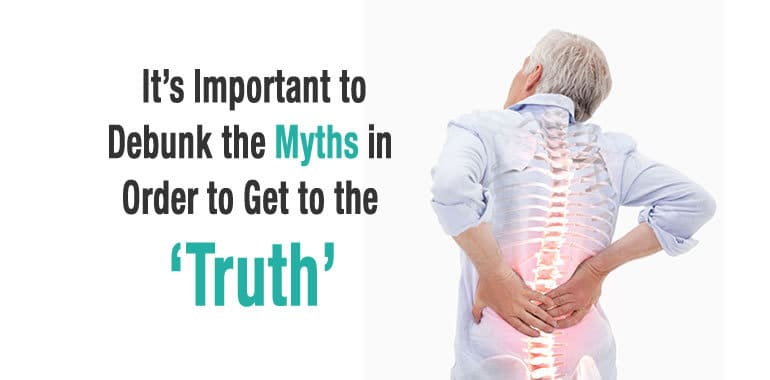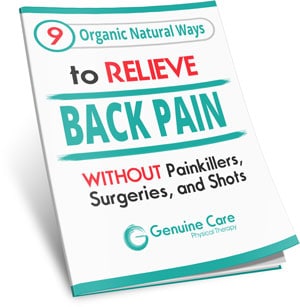
Lower back pain affects around 60-90% of individuals during their lifetime. In fact, it is the most common reason people seek medical attention, second only to the common cold. That having been said, what does such a figure cost? In the U.S alone, we spend more money on the management of back pain ($90 billion a year) than on cancer research, or even on foreign aid government expenditure! Back pain is so common that it’s likely you will know someone at work or in your family suffering from it. And yet, despite this massive social issue, most people remain misinformed about what causes back pain and how it can be overcome. In this post, I hope to differentiate the facts from the myths in order to help you manage and overcome back pain, right now.
Because of the misunderstood nature of back pain, it’s important to debunk the myths in order to get to the truth. So, let’s jump straight in:
Myth 1
“I am in pain, so I need to rest.”
This is one of the most common misconceptions. In fact, research strongly opposes this idea. Rest is NOT a way to overcome back pain. In truth, the way to health is to not rest longer than 1-2 days at a time. People who spend too much time resting their backs are generally considered “avoiders”, that is, people who want to avoid any activities due to pain. Avoiders have a much higher risk of developing increased, chronic pain. Of course, I’m not suggesting you find activities that necessarily increase your pain, but I am suggesting that you stay active by doing other activities that don’t provoke the issue. Why not try gentle walking or Pilates? Make the decision to get out of bed and find some activities that you enjoy doing. That is the key to overcoming your back pain.
Myth 2
“My back pain is constant and not getting better… that means something is seriously wrong.”
The fact of the matter is, regardless of what one might imagine, the spine is an incredibly strong structure with great support offered by muscles, ligaments, tendons, etc. Thus, the vast majority of lower back pain happens in the absence of serious structural damage (>90%). Only 1% of people with low back pain have serious problems such as a tumors, inflammation, or infection. Only 2% of back pain comes from other organs such as the bladder, kidney, prostate, etc. True sciatica, or “nerve pinching”, happens to only 5% or less of the total population suffering from back pain. Therefore, it’s important to understand that back pain isn’t necessary to do with structural damage: the rarity of spinal issues present in back pain sufferers is evident in the research. The truth is, finding the root cause of the problem is essential to healing back pain, and more often than not there is no serious structural damage at all.
Myth 3
“I need to have an MRI test to show what is wrong.”
An MRI should not be your first port of call in the case of back pain. Only if conservative therapy has failed should you consider taking a MRI or X-ray. If you have neurological signs such as foot dropping/dragging, sensation changes, bowel/bladder function changes, and/or a shooting pains down the leg, then a MRI is recommended. Research shows that the results of a MRI, that is, possible structural damage or abnormalities, do not accurately predict what contributes to back pain. In fact, even if you do not feel any back pain, a MRI may falsely predict that you do feel pain. The truth is, 50-80% of individuals who have spinal disc problems, as indicated by an MRI, have no complaints about back pain. One study even shows that taking a MRI in the early stages of pain tripled the recommendations for surgery, but did not improve the outcome for the patient. Make a MRI your last option.
Myth 4
“Heat and massages make me feel better, so I am sure they will cure me.”
In truth, heat and massages only give you temporary relief. Research indicates that both options lack long term benefits. That having been said, both heat treatments and massages can be used as a supplement to physical therapy and stretching. Heat and massages help your muscles to relax, but in most cases tight muscles aren’t the source of your back pain: they are just a by-product of the main issue.
Myth 5
“An inversion table will cure my sciatica.”
An inversion table is a device used, in some cases, to treat back pain. The patient’s feet are strapped in and he/she is tilted backwards, thereby applying traction force to the spine through the use of body weight. It has gained popularity in the last few years, and in physical therapy treatment we sometimes use a traction machine to help patients. Ours, however, is horizontal. Importantly, though, in physical therapy we only use traction devices in special cases. In fact, according to Stanton’s 2011 study, less than 10% of patients with back pain fall into the group that might benefit from traction. In other words, inversion tables or traction machines have benefits, but are not for everybody. In order to determine whether somebody will benefit from traction, one must perform a thorough examination, preferably conducted by a professional physical therapist. Another point to consider before using this type of device is blood flow. In an inverted position, blood pressure in the brain and eyeballs increases dramatically, so it is not recommended for those who have high blood pressure or eye problems.
Myth 6
“I have back pain because of my age.”
As we all know, aging is irreversible and is accompanied changes. This is no different when it comes to our spine. Normal aging processes affect our backs by narrowing the spinal joint spaces and thinning the discs. Despite this, the occurrence of back pain is actually most prevalent between the ages of 35-55. Age doesn’t seem to play a massive role in back pain! By not resigning to lower-back pain as an expected symptom of aging, your chances of recovery will increase significantly.
Despite diminishing reimbursement rates for medical services, physical therapy is one of the few professions that still takes the time to perform a comprehensive physical examination in order to determine a course of treatment. Genuine Care Physical Therapy is one the very few clinics that utilizes 1:1 treatment with a licensed, board-certified specialist. Furthermore, our sessions last for over an hour. Even without a referral, our qualified physical therapists can make the differences you need. We can suggest a customized plan for individuals with lower back pain. Moreover, physical therapists can help restore the motion that you’ve lost via the use of hands-on treatment of spinal joints, muscles, and soft tissues. Physical therapists can also prescribe exercises fit for each individual’s needs. Furthermore, they can also instruct patients about proper body mechanics and strengthening programs in order to substantially lower the chance of the problem resurfacing.
Don’t let back pain determine the quality of your life. With 6 common myths now debunked, we invite you to call us TODAY for more information and treatment. We look forward to helping you achieve the pain free, active lifestyle you deserve.
References:
Martin BI, Deyo RA, Mirza SK, et al. Expenditures and health status among adults with back and neck problems. JAMA. 2008;299:656-664. http://dx.doi.org/10.1001/jama.299.6.656
George SZ, Fritz JM, Bialosky JE, Donald DA. The effect of a fear-avoidance-based physical therapy intervention for patients with acute low back pain: results of a randomized clinical trial. Spine (Phila Pa 1976). 2003;28:2551-2560. http:// dx.doi.org/10.1097/01.BRS.0000096677.84605. A2
Carragee E, Alamin T, Cheng I, Franklin T, van den Haak E, Hurwitz E. Are first-time episodes of serious LBP associated with new MRI findings? Spine J. 2006;6:624-635. http://dx.doi. org/10.1016/j.spinee.2006.03.005
Deyo RA, Mirza SK, Turner JA, Martin BI. Overtreating chronic back pain: time to back off? J Am Board Fam Med. 2009;22:62-68.
- Stop treating people like dead - March 25, 2024
- Stop Asking Me ‘Where are you from?” - March 25, 2024
- You Need the Right Diagnosis, not the Right Technique - November 25, 2020






